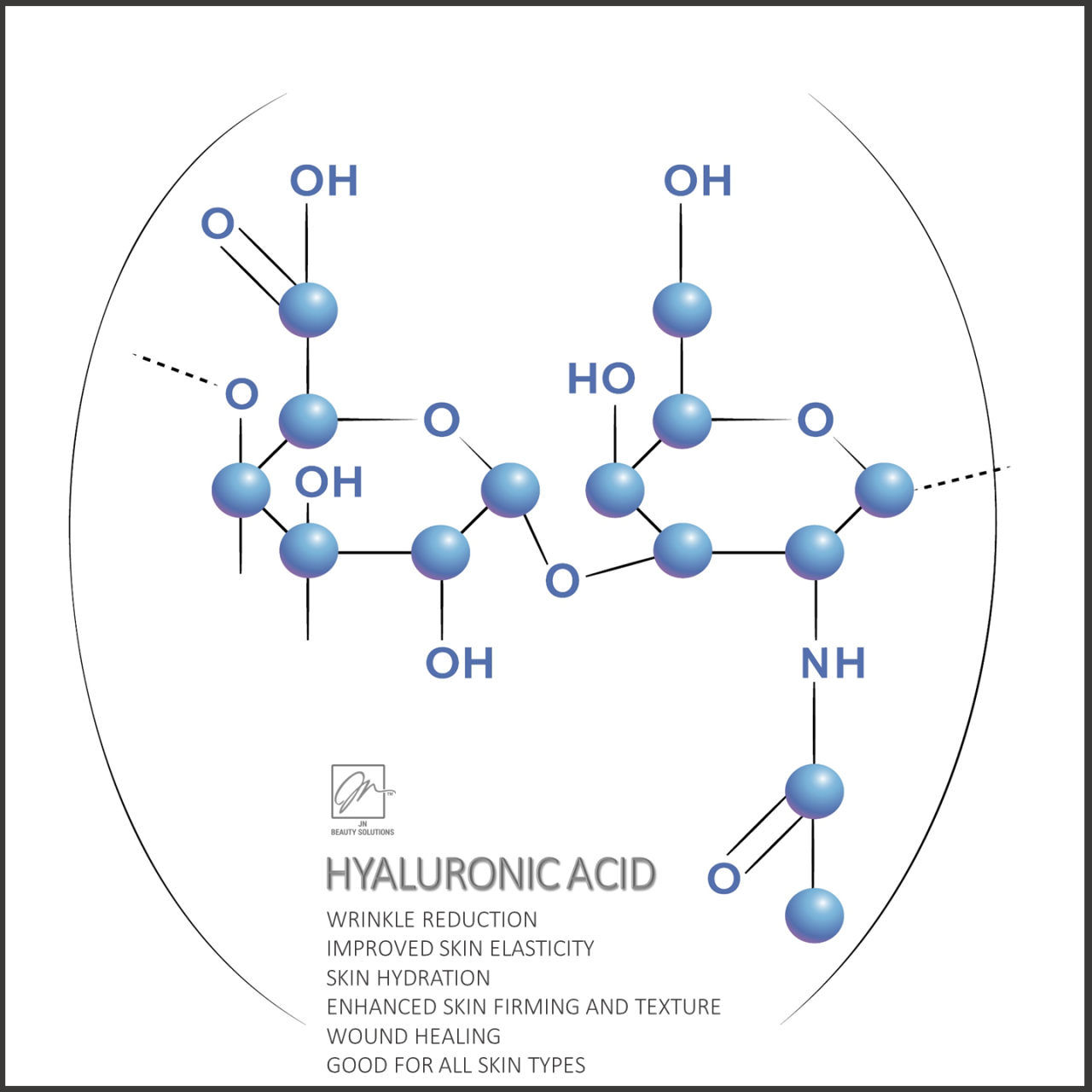Hyaluronic Acid (HA): Overview and Uses
Hyaluronic acid (HA) is a naturally occurring substance found in the human body, particularly in the skin, eyes, and connective tissues. It is a glycosaminoglycan—a type of molecule composed of sugars and amino acids.
HA plays a crucial role in maintaining moisture and lubrication throughout the body. In the skin, it helps retain water, keeping it hydrated and plump. It also contributes to the skin’s elasticity and firmness.
Due to its hydrating and lubricating properties, hyaluronic acid has become a popular ingredient in skincare products, particularly moisturizers, serums, and anti-aging treatments. It is known for its ability to attract and retain water molecules, which helps improve skin hydration and reduce the appearance of fine lines and wrinkles.
Beyond skincare, HA is used in various medical and cosmetic procedures. It can be injected into the skin to add volume and reduce wrinkles, making it a common component in dermal fillers. It is also used in ophthalmic surgery, orthopedics, and in some oral supplements.
Although hyaluronic acid is generally safe for use, it is always advisable to consult a healthcare professional or dermatologist before beginning any new skincare or cosmetic regimen, especially if you have specific skin concerns or medical conditions.
Key Benefits of Hyaluronic Acid
-
Skin Hydration:
HA can hold up to 1,000 times its weight in water, making it exceptionally effective at keeping the skin hydrated. This boosts the skin’s texture, elasticity, and overall appearance—leaving it plumper, smoother, and more supple. -
Wrinkle Reduction:
As we age, natural HA production decreases, leading to dryness, loss of volume, and fine lines. Topical application or injectable HA can help replenish lost moisture and volume, reducing visible signs of aging. -
Skin Firmness and Elasticity:
HA supports collagen production, which contributes to skin strength and elasticity. This can help improve skin tone and reduce sagging. -
Wound Healing:
HA promotes tissue regeneration and supports cell migration, which plays a role in healing cuts, wounds, and other skin injuries. -
Joint Health:
HA is present in synovial fluid, which lubricates and cushions joints. HA supplements or injections can help relieve joint pain, improve mobility, and provide relief from conditions such as osteoarthritis. -
Eye Health:
HA is found in high concentrations in the vitreous humor of the eye, helping to maintain its shape and support surrounding tissues. HA-based eye drops are used to relieve dryness and discomfort.
Note: Individual results may vary. The effectiveness of HA depends on factors like formulation, concentration, and method of application. Consultation with a healthcare provider is recommended for optimal use.
Forms of Hyaluronic Acid
HA comes in different forms, depending on molecular weight and formulation:
-
High Molecular Weight Hyaluronic Acid:
Remains on the skin’s surface and forms a hydrating barrier. Commonly used in moisturizers and serums for surface hydration and plumping. -
Low Molecular Weight Hyaluronic Acid:
Smaller molecules penetrate deeper into the skin, targeting fine lines, wrinkles, and improving elasticity by stimulating collagen production. -
Cross-linked Hyaluronic Acid:
A chemically modified gel form with extended longevity. Frequently used in injectable dermal fillers to add volume and smooth out wrinkles.
Frequently Asked Questions (FAQs)
Q: Where is hyaluronic acid extracted from?
A: HA is sourced in the following ways:
-
Rooster combs: Historically common but now less used due to ethical concerns.
-
Bacterial fermentation: The most common method today, using bacteria like Streptococcus equi or Streptococcus zooepidemicus in controlled environments.
-
Plant-based sources: Found in small amounts in wheat germ, soybeans, and other plants. However, these are less commonly used due to low yield.
Q: How many forms of hyaluronic acid are there?
A: There are three main forms used in skincare:
-
Hydrolyzed Hyaluronic Acid
-
Sodium Acetylated Hyaluronate
-
Sodium Hyaluronate
Q: Why do some people say there are 7 types of hyaluronic acid?
A: Some advanced formulations include seven molecular variations for layered hydration. These include:
-
Sodium Hyaluronate
-
Hydrolyzed Hyaluronic Acid
-
Sodium Hyaluronate Crosspolymer
-
Hyaluronic Acid
-
Hydrolyzed Sodium Hyaluronate
-
Sodium Acetylated Hyaluronate
-
Hydroxypropyltrimonium Hyaluronate
Q: What’s the difference between Hydrolyzed Hyaluronic Acid and regular Hyaluronic Acid?
A: Hydrolyzed HA is broken down into smaller molecules that can penetrate the skin more easily. It offers light hydration and is ideal for oily or combination skin types that require less intense moisturization.
Q: What ingredients should I look for in HA products?
A: Key ingredients to look for include:
-
Hydrolyzed Hyaluronic Acid
-
Sodium Acetylated Hyaluronate
-
Sodium Hyaluronate
Q: What moisturizers work well with HA?
A: HA pairs well with other hydrating ingredients like:
-
Ceramides
-
Vitamin E
-
Aloe Vera
These help soothe the skin and counterbalance drying agents like retinol.
Q: What should not be mixed with HA?
A: HA is generally compatible with most skincare ingredients. There are no well-known negative interactions.
Q: What percentage of HA is most effective?
A: Experts suggest that a 30% concentration of high molecular weight sodium hyaluronate gel may offer optimal hydration. However, effective concentrations typically range from 0.1% to 2% in skincare products.
Q: What is the most natural source of HA?
A: You can boost natural HA production by consuming:
-
Leafy greens
-
Soy-based foods
-
Citrus fruits
-
Root vegetables
Bone broth is also a rich source of naturally occurring hyaluronic acid.
Q: Who should avoid hyaluronic acid?
A: HA is generally safe, but individuals who are pregnant, breastfeeding, or have a history of cancer should consult a doctor before using HA supplements or undergoing HA-based treatments.
Q: How long should I wait before applying moisturizer after HA?
A: Wait approximately 5–10 minutes after applying HA serum, allowing it to absorb fully before sealing it in with a moisturizer.
For more info about this please contact us
JN Beauty Solutions™


